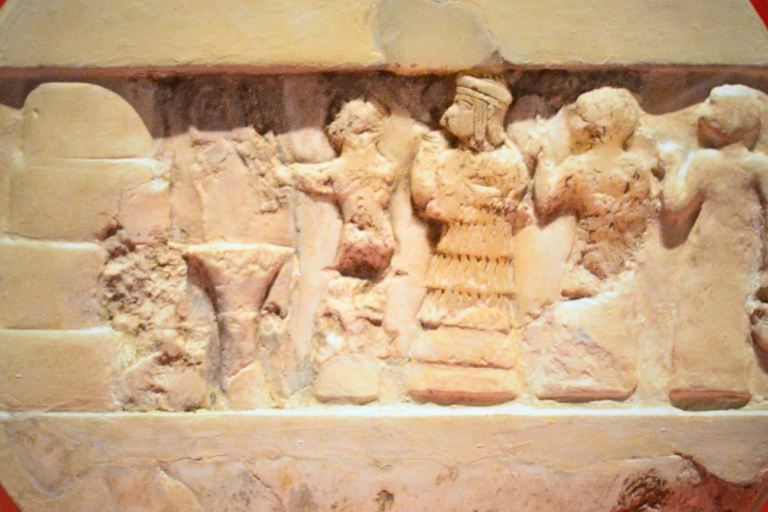
[ad_1]

It was during the reign of her father — Sargon of Akkad, arguably the first emperor in history — that Enheduanna declared her own genius. After writing a temple hymn lauding the powers of the Sumerian goddess of writing and grain, the high priestess signed her own name with a flourish.
More than 4,200 years later, archaeologists and literary enthusiasts seem to agree: Enheduanna is the earliest known named author in history.
Who Was Enheduanna?
Like many other famous writers, Enheduanna didn’t reach this level of artistic acumen without having first experiencing her share of trauma and violence.
By her own account, she may have survived sexual violence during a rebellion that temporarily deposed her position as high priestess in the Sumerian city-state of Ur. But she persevered and continued to support her father’s dynasty through her position and through writing — even after his death.
“She certainly had a very powerful cultic and political role to play,” says Sidney Babcock, curator of ancient western seals and tablets at the Morgan Library and Museum in New York City. Babcock recently led an exhibition that drew the largest assemblage of artifacts related to Enheduanna and the poems attributed to her at the museum.
And yet, we don’t actually know many of the basic biographical facts of Enheduanna’s life. Was she the first-born daughter of Sargon? Who was her mother? When exactly was she born? And when did she die?
In fact, we don’t even know if Enheduanna was the name she was given at birth. From Sumerian, Babcock explains, the name translates to something like “high priestess, ornament of the heaven.”
Read More: Who Were the Ancient Sumerians?
Enheduanna and Akkadia
The Akkadian ruler Sargon created the world’s first empire by unifying several Mesopotamian city-states in the Akkadian north and the Sumerian south. Enheduanna’s name was likely taken on when the princess became the high priestess to Inanna, the powerful Sumerian goddess.
The maneuver was political — an effort to cement relationships between her father and the conquered city of Ur, where Inanna was the patron deity. By becoming high priestess, Enheduanna embodied the goddess’ earthly consort.
“It’s a way [for the Akkadian conquerors] to show respect for the traditions of the past,” says Babcock. “It’s a tremendous asset to her father’s political ambitions.”
Enheduanna didn’t sit idly by while enjoying her privileged position, though. The poetry she wrote is beautiful — but it also has a political side, which helped to bolster her own status as a representative of Inanna.
Read More: The Rise of the Akkadians
Enheduanna’s Hymns
Her Exaltation of Inanna describes a real period after Sargon, when someone named Lugal-Ane rebels and takes power in Ur — banishing Enheduanna and possibly committing sexual violence on her, Babcock says. The poem itself describes this situation: Enheduanna flees from a window and asks Inanna to intercede on behalf of Sargon’s dynasty.
This seems to have worked, as Naram-Sim, the grandson of Sargon, eventually reconquered Ur.
Babcock, praising the “beauty and intense sincerity” of the poem, says Enheduanna uses an innovative switch of perspective —first and third person — to narrate the events and praise Inanna. She also compares writing the poem to giving birth, he says.
“She’s appealing to the goddess in the way she thinks is the most important,” Babcock says. “The act of writing has become so special that she writes about the act.”
The poem finishes with a return of order, Babcock notes. This is a powerful message backing the legitimacy of her nephew’s rule. Inanna is also placated and given credit for destroying the enemy.
Some Aren’t So Sure
Yet a number of scholars have cast doubt on whether Enheduanna is really the author of some, or even all, of the poems attributed to her. It’s true that most of the surviving texts of her poems aren’t contemporary with her life. Instead, they are derived from copies made centuries after she lived.
“I can see why they tried to copy it in the scribal schools because it’s just so rich,” Babcock says.
Unfortunately, some of these poems include language that wouldn’t have been used in Enheduanna’s time. Some scholars see this as evidence that Enheduanna herself didn’t actually write them. But Babcock believes these simply represent language that was miscopied or modernized from the original over the years.
In comparison, he notes that the oldest copy of Metamorphoses dates to about a millennium after Ovid lived — and his authorship is not questioned nearly as much.
The fact that Enheduanna is female plays a major role in this source of doubt, Babcock believes. “It’s frustrating really,” he says, adding that many of the political elements of her work would be meaningless to a charlatan who created a fake document five centuries later.
The Enheduanna Effect
Unlike some of the named authors we know from later millennia, like Homer and Sappho, we do know what Enheduanna looked like — thanks to a named alabaster disk discovered in excavations of the temple where she likely lived.
Babcock’s exhibition also included art he believes is inspired by Enheduanna’s poetry. Her three dozen temple hymns are extensive, with each describing the attributes of the different religious cults in cities across the empire.
Around the same time that Enheduanna lived, Babcock says, a “profusion” of images and artifacts of gods and goddesses begin to appear in the archaeological record. “This is one of the first examples of literature inspiring art,” he says. “The visual evidence hadn’t been considered before.”
Despite being disregarded by many scholars for centuries or perhaps millennia, however, Enheduanna may finally be getting her due: In addition to the recent exhibition at the Morgan Library and Museum, Babcock knows of a few new translations and biographies of the world’s first known named poet, princess and high priestess.
“I’m delighted she’s having her moment,” Babcock says.
Read More: Decoding Cuneiform, One of the Earliest Forms of Writing
[ad_2]